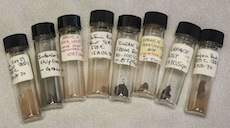Introduction
At LBNL, artifacts can take many forms: mechanical equipment, models of proposed equipment and facilities, plaques and awards, scrapbooks, photo albums, posters and artwork, guest books from lab events, and objects that may or may not have scientific significance, but were used by prominent scientists. Artifacts are considered non-record material and do not fall under the records retention schedules. Since artifacts cannot be stored at the Federal Records Center, a determination has to be made as to which ones are worth maintaining or donating to other institutions.
Why Accession Artifacts?
Artifacts at LBNL aid in areas of historical research, help define a sense of scientific community and pride in past accomplishments, and validate the historic and scientific importance of the lab. Accessioning artifacts is solely the responsibility of the Archives and Records Office as detailed in the RPM Chapter 1 §1.17.D.4.8.
Guidelines for Accessioning Artifacts
What Artifacts are Considered for Accessioning?
- One of a kind pieces of equipment that demonstrate novel and highly significant scientific developments at LBNL.
- Equipment and objects used by prominent scientists, Nobel Laureates, or those involved in highly significant research conducted at LBNL.
- Objects of historical value associated with the lab such as the original Radiation Lab door.
- Models of significant scientific equipment or facilities such as the Bevatron.
- Plaques and awards given to prominent LBNL scientists.
- Photo albums of significant lab events.
- Signed guest books from significant lab events.
What Questions Will Be Asked of Potential Donors?
What is the significance of the artifact?
What project and/or scientist was it associated with?
Was the research project highly significant?
How was the artifact used?
Who originally maintained the artifact and where was it stored previously?
What is the size of the artifact? Is it a large piece of equipment or model that needs special storage considerations?
- Is the artifact suitable for display?
- Can the artifact be donated to another institution?
- Is there another institution that may be interested in the artifact?
Contact Information
For more information on identifying and accessioning historic LBNL artifacts, please contact Karen Nelson at KCNelson@lbl.gov or at 510-486-4686.
Melvin Calvin's Moon Dust Returned to NASA
Artifact of the Month
